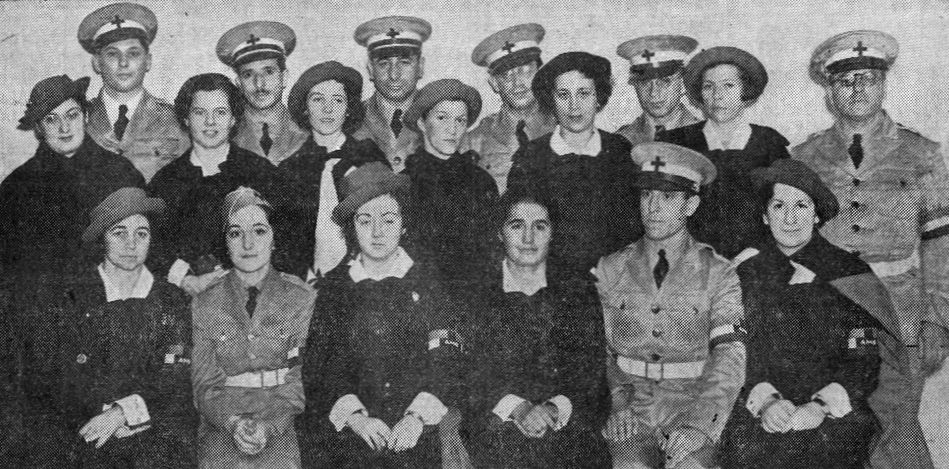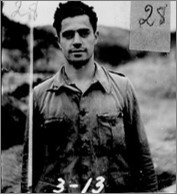Returning Home: Three Sephardim in the Spanish Civil War
Among the thousands of Jewish volunteers who joined the International Brigades were many descendants of the Sephardim. What was it like for them to “return” to Spain? Three case studies: Lini de Vries, César Covo, and Samuel Nahman, aka Manny Harriman.
In the documentary Invisible Heroes: African Americans in the Spanish Civil War, James Fernández points out that Robert Jordan, the protagonist of Ernest Hemingway’s For Whom the Bell Tolls, is anything but representative of the International Brigade volunteers. A WASP and solitary idealist from Montana, Jordan is in Spain without a clear motivation. The real volunteers comprised a much more colorful and committed spectrum. Hailing from vibrant and mobilized activist communities and marked by lived and generational experiences with trauma, injustice, and oppression, they were driven by a fervent desire for social transformation. It’s no coincidence that the percentage of Jewish volunteers in the International Brigades, estimated between 15 and 25, was strikingly disproportionate to their share in the population of their countries. Among the US volunteers, this percentage was likely close to 40.
Whether they joined the Brigades as Jews, however, is less clear. The surviving volunteers long underplayed their weight of their ethnic identity: They went to Spain not because they were Jews but because they were antifascists. Still, the work of scholars like Cynthia Gabbay, Ranaan Rein, Joseph Butwin, and Gerben Zaagsma suggests that Jewishness may have been a more important motivating factor than the volunteers themselves were willing to admit.
How did this play out for the descendants of the Jews who were expelled from the Iberian Peninsula (Sepharad) in the fifteenth century, the Sephardim? Like other members of the Jewish diaspora, they had lived through violence, ghettoization, and expulsion from their adopted homelands. But did their Iberian roots matter? Here, we’ll explore that question through the testimonies of three Sephardic volunteers: the Dutch American nurse Lini de Vries (1905-1982), the French volunteer César Covo (1912-2015), and the US volunteer Samuel Nahman (1919-1997), better known as Manny Harriman, who was also the co-author’s uncle.
Nahman, it turns out, felt called to fight in Spain, in no small part, because of his ancestral Sephardic connection to the Iberian Peninsula. He came from a powerful and well-established Sephardic family. His most noted ancestor, Rabbi Moses ben Nahman of Girona (1194-1270), also known as Nahmánides or Bonastruc da Porta, was Chief Rabbi of Catalonia and physician to King Jaume I of Aragon, best known for his role in a famous 1263 dispute, where he argued forcefully from the Hebrew scriptures that Jesus was not the Messiah. Despite the king’s initial promise to grant Moses ben Nahman freedom of speech, the king was coerced by the Dominicans, and eventually the Pope, to banish the rabbi from Spain. Nahmánides escaped to Palestine in 1267, from where he corresponded extensively with his homeland.
Samuel Nahman, aka Manny Harriman, was born in 1919 in New York City. According to his niece, Nancy Blaustein, he grew up with the oral history of Nahmánides and the story of his family’s ability to survive the diaspora from Spain while remaining true to their values and maintaining their Sephardic identity. This included the tradition of naming all firstborn sons Joseph, in honor of Rabbi Nahman’s youngest son. Later, when the famous Jewish Encyclopedia was published in 1971, the family confirmed that the oral history about Rabbi Nahman’s disputation that had been passed down through generations was true.

ALB volunteers returning from Spain, Dec. 15, 1938. Manny Harriman/Nahman is the fourth from the right.
As the son of two Sephardic parents born in present-day Turkey, Haim Joseph Nahman and Gentile Soulam, Sam Nahman grew up speaking Ladino. Only later, on a picket line, did he learn that his home language was a form of thirteenth-century Spanish, mixed with other languages reflecting the diaspora. Gregarious, social, and intelligent, Nahman had to leave school at the age of 13 to work with his father as a shoemaker, often working long hours from 8 am until midnight. New York of the 1930s was an unforgiving, divided, harsh place to live, especially for a first-generation Jew from a working-class community, but Nahman came from a loving, supportive, curious family with a strong value system that drove its ethics and a sense of identity. Nahman, with his parents’ permission, enlisted in the International Brigades when he was only 19. He fought from May to December 1938.
After Franco’s death, Nahman returned to Spain several times. He also became involved with the Veterans of the Abraham Lincoln Brigade as editor of The Volunteer. In 1983, he and his family traveled to Girona, where were welcomed with open arms. They were surprised to see that the cultural history of Nahmánides had been conserved and celebrated. In an interview with a local Girona newspaper, Nahman said: “Our parents have always spoken to us in Ladino, and we have maintained this language among ourselves. They also explained to us where we were from, where our families had lived for centuries. For this reason, it allows me to call myself Catalan, because I believe I am, rightly so, like everyone else who lives here.” (After 1983, Nahman/Harriman set out to record the oral histories of all the remaining veterans. Today, the Manny Harriman Collection at Tamiment Library holds the testimonies of more than 180 veterans.)
 Lini de Vries, who was born as Lena Moerkerk to Dutch immigrant parents in New Jersey, spent her early years in Paterson and worked in the silk mills as a child. In 1937, she volunteered as a nurse for the Medical Bureau to Aid Spanish Democracy. Facing harassment from the FBI in the 1950s, she moved to Mexico, where she became a health activist in rural indigenous Mexico and a distinguished professor at the Universidad Veracruzana in Jalapa. Later in life, she wrote several memoirs, in which antisemitism looms large. Her mother, she explains, had married a Dutch protestant to hide her Jewish identity. After the 1940 German invasion, her Jewish family in Holland faced persecution. Later, Lini herself felt compelled to hide her Jewish heritage from her husband’s family.
Lini de Vries, who was born as Lena Moerkerk to Dutch immigrant parents in New Jersey, spent her early years in Paterson and worked in the silk mills as a child. In 1937, she volunteered as a nurse for the Medical Bureau to Aid Spanish Democracy. Facing harassment from the FBI in the 1950s, she moved to Mexico, where she became a health activist in rural indigenous Mexico and a distinguished professor at the Universidad Veracruzana in Jalapa. Later in life, she wrote several memoirs, in which antisemitism looms large. Her mother, she explains, had married a Dutch protestant to hide her Jewish identity. After the 1940 German invasion, her Jewish family in Holland faced persecution. Later, Lini herself felt compelled to hide her Jewish heritage from her husband’s family.
Still, as a Sephardic Jew, Lini felt a deep connection with her heritage. In a 1965 memoir, she describes the moment she first arrived in Spain:
I felt the impulse to pick up a handful of Spanish soil and keep it in my bosom. What a strange wish! I felt as if, after a long pilgrimage, I had returned home. Walking away from the group, I walked along the seashore. I was looking for solitude so that my hidden thoughts could emerge to the surface, while I contemplated the waves. I bent down to pick up a handful of sand. I squeezed it firmly. Three centuries earlier, Isabel had expelled my ancestors from Spain, Sephardic Jews, who, residing in Holland, helped liberate the country from Spanish domination in the 16th century. Now we were in the 20th century, in 1937. I was a first-generation American, although I felt Dutch. However, upon stepping onto Spanish land it seemed to me that I had finally returned to the pristine abode: the entire land hurt me. Who would I share my concerns with? With nobody. Deep is the loneliness of the human being.
The French volunteer César Covo, also of Sephardic origin, also felt a deep solidarity with the Spanish people despite his family’s memory of inquisition, persecution, and expulsion. In his memoir, he recalls a dialogue with a fellow volunteer:
—Despite the Inquisition, you did not hesitate to go, while yours were tortured there in other times. Maybe you’re going with the intention of getting revenge?
—First of all, I am going as an anti-fascist, which would be reason enough. As for the Inquisition, it is true that there is still some resentment, but let us carefully examine the problem of that time, who were the architects of the Inquisition? That was not caused by the Spanish people nor by the bourgeoisie. On the contrary, it is known that at that time the common people encouraged the persecuted to accept baptism, considering that this solution was preferable to exile and persecution. The bourgeoisie and part of the nobility, came to the aid of the persecuted, in many cases lent them their Spanish surnames to save them from the Inquisition. Today a good number of those Sephardic Jews preserve the names and surnames that the Spanish offered to their ancestors.
The memoirs of Nahman, De Vries, and Covo suggest that the Spanish Civil war resonated strongly with Jewish people of Sephardic heritage. What is striking about these three volunteers is their expansive sense of collective memory—a memory that connects rather than competes. They are perfect examples of that Michael Rothberg calls “multi-directional memory.” Considering collective memory in multicultural and transnational contexts, Rothberg allows us to see links between memories of trauma and oppression that may span several centuries—for example, tying the Holocaust to the history of colonialism. The International Brigades, of course, were true laboratory of multidirectional memory in this sense: Some 35,000 individuals from around the world took their lived and generational experiences with trauma, injustice and oppression and transformed them into action in the fight against fascism. Instead of waging a competitive struggle for recognition of their own group, as if recognition were a scarce resource, they made connections. In a similar way, Harlem writer Langston Hughes, a war correspondent during the Spanish Civil War, pointed to the deep links between European fascism and racist oppression in the United States.
Rather than viewing oppression through the lens of disparate group identities, as we often see happen today, these three memoirs recognize and identify their entanglement. As Sephardic Jews, Nahman, De Vries and Covo, each in their own way, were driven by their own multigenerational memory of persecution, which compelled them to recognize Spain as their long-lost homeland, while also presenting a case for solidarity with the Spanish people as victims of injustice. “The International Brigades were a babble of tongues,” Samuel later wrote in his letter to his daughter. “But it was such a healing sight, to be part of this battle, of people all subjugating their own individual interests—communists, socialists, independents…people who would not see eye to eye in every single thing—to come together.”
Delicia Nahman, a niece of Samuel Nahman, grew up in L.A., is a graduate of UC Berkeley, and has lived in Mexico and Chile. She holds an MBA in Sustainability from Bard and currently works as Sustainability Director at Lafayette College in Easton, PA. Katherine O. Stafford, Associate Professor of Spanish at Lafayette College, is the author of several books and articles about the Spanish Civil War, including Narrating War in Peace: The Spanish Civil War in the Transition and Today (Palgrave 2015).















